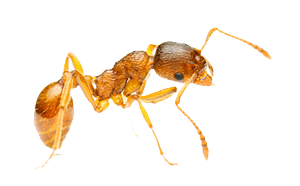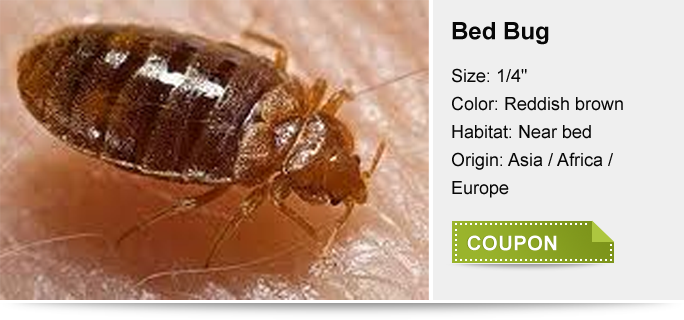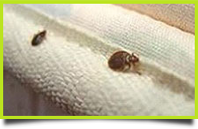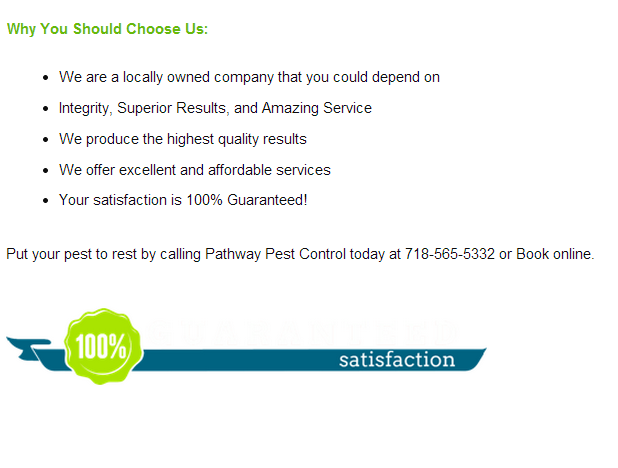Anti-Pest Home Protection Services
Many common household pests can pose serious concerns and health risks to your family due to their ability to bite, sting, chew, and carry diseases, such as mosquitoes, fire ants, cockroaches, and mice.
In addition to being a nuisance, these pests can cause a significant amount of damage to your home and business. It is important to fully understand the danger stemming from these types of infestations and how to protect your home, family, and business from these common pests: ants, bedbugs, termites, and other pests.
Year-Round Home Pest Control Protection Plan
To prevent and protect your home from all these pests mentioned above, we will send you the best technician, well-trained, state-tested, and registered with the New York Department of Environment Control, so you can rest assured that your home or business is being treated by a professional.
Put your pest to rest by calling Pathway Pest Control at (718) 565-5332.

Pest Protection
Protection for your home and family from the most common pests
Bedbugs and Household Pests
We will provide you with the best service to eradicate all your pests.
Carpenter Ants and Bees
These insects are dangerous. They will eventually destroy your home if not treated.
Homeowners need someone that they trust. That is why they turn to us for termite control.
Economic Importance
Ants may affect us adversely by stinging or biting; invading and contaminating food; nesting in lawns, golf courses, or within premises; stealing seeds from seed beds or feeding on germinating seeds; defoliating or gnawing into plants and plant products; killing young poultry, birds, livestock, or game; simply annoying humans and animals with their presence; and possibly, transmitting certain human diseases after crawling over sputum, feces, carrion, and so forth.
Some carpenter ants can cause serious structural damage to wooden structures. However, only a small number of all the ant species are damaging or medically significant due to their stinging behavior, and require control because of these factors.
Identification of Pest Species
Because of the wide variations in feeding and other habits of different ant species, their successful management often requires exact identification of the species involved. This knowledge allows the professional to gain accurate information.
Major Pest Species

Carpenter Ants
Carpenter ants are among the most conspicuous of ants found in and around homes, being large and typically blackish or very dark-bodied.
Foraging workers have rather large mandibles, which they can bite or give a strong pinch.
Carpenter ants will establish nests in a number of different locations. Outdoor sites include stumps, hollow logs, telephone poles, fence posts, or other similar large pieces of wood. Wood that is moist or partially decayed is preferred by many species, especially in the northeastern United States; however, cracks, crevices, and other cavities may be used to start a nest in sound wood.
Ants may be carried into homes in firewood or enter and establish colonies via other routes. Often ants move into a building solely to feed.
Carpenter ants excavate nest galleries in wood. These galleries somewhat resemble the work of termites but can be distinguished by their entirely clean and almost sandpapered appearance.
They are frequently hollowed in moist or unsound wood, although carpenter ants can burrow in sound wood. Carpenter ants do not use wood for food.

Pharaoh Ants
Pharaoh ants are light yellowish to reddish-brown in color. They are found in localized regions throughout most of the United States and part of southern Canada. They have become a common pest in many areas.
They are an important ant pest in homes, apartments, hotels, grocery stores, restaurants, hospitals, nursing homes, and other facilities throughout much of their range.
Their small size, which enables them to get into almost anything, and their very wide food preferences combine to make pharaoh ants difficult to eliminate from structures in many cases.
Pharaoh ants will feed on such a diverse array of materials that the usage of the term food preferences seems inappropriate. However, substances like syrups, fruit juice, honey, jelly, cakes, pies, greases, dead insects, or meats and blood are frequently fed on.
In hospitals, they will often feed on blood and other bodily fluids, medical waste, or intravenous feeding fluids. Occasionally, when a particularly good food resource is found, especially close to the nest, some queens can be seen traveling to and from the food location.
Typically, however, the queens remain in the nest and are not seen, or importantly, cannot be controlled without the use of an effective bait that the foragers must bring back to the nest and feed to the queens.
Ant Control
The proper procedure for ant control in and around homes or other buildings depend greatly on the species of ant involved, the extent and nature of the infestation, and the location of the nest or nests used by the infesting species.
Rodents as Health Pests
Rodents have been responsible for, or implicated in, the spread of many diseases to people and domestic animals-especially in years past. Today however because of sanitation, effective drugs, and rodent and insect control programs, the disease threat from rodents is not as significant as it once was.
Mouse allergens
Research in 1999 of children in inner-city areas of eight major cities demonstrated that the house mouse carries a protein within its urine that can trigger severe cases of asthma and allergic rhinitis in susceptible people. Considering that mice typically urinate in microdroplets in many, many spots as they forage about inside a room, literally thousands of micro areas on surfaces can be covered with mouse urine inside homes or schools, offices, etc., that contain significant mouse infestation. As a result of this finding, the ordinary house mouse is considered much more a health pest than in the past.
Salmonella bacteria are actually common in the natural environment. Thus far, it is estimated that about 2,000 different strains (serotypes) of salmonella exist. Certain types are highly pathogenic to people and other animals and can cause salmonellosis (acute food poisoning). Tow serotypes in particular are associated with rodents and food poisoning: Salmonella typhimurius and S.enteriditis.
Salmonella can thrive on decaying food , on poultry and meats, in sewers, livestock facilities, septic tanks, cesspools, accumulated garbage, and other similar unsanitary environments. Because rodents frequent these areas and then visit homes and food facilities, the potential for spread of the salmonella is real because the bacteria thrive in the intestinal tract of rodents, and hence are spread intestinal tract of rodents, and hence are spread through food contaminated with rodent feces.

In the United States, approximately two million cases of salmonellosis occur each year. To date, research has shown that rats and mice may do not play a major role in the direct spread of salmonellosis to humans. In livestock facilities however, such as poultry operations, the house mouse can have significant involvement in amplifying the spread of salmonella.
Rat-bite fever is caused by the bacterium streptobacillis moniliformis that can live in the saliva of both rats and mice. This bacteria causes flu-like symptoms lasting for several days, but in severe cases (which are rare), it can be fatal.

Other diseases the general public (including physicians) sometimes mistakenly associate the bites of rodents with the potential of rabies transmission. But wild commensal rodents have not been found to transmit rabies. Thus, the U.S Public Health Service does recommend specific anti-rabies treatments in the event of rat and mouse bites. Rodents have been implicated with transmitting several other diseases. Lymphocytic chori-omeningitis (LCM) may be spread by mice, as has cities over the past several years. Trichinosis caused by the trichina worn, can be harbored and shed by rats via their feces into hog feed. Rats have also been shown to carry the organisms of typhoid, dysentery, and several other diseases.
Rodents as Economic Pests
Rat and mice attack our food in the farm fields, orchards and livestock facilities, during its processing, storage and transport, and while it is in our supermarkets, restaurant, and homes. In this regards, the rodents have been referred to as pletoparasitic: meaning they parasitize us via staling our valuable resources. They also spoil tons of food by contaminating it with their urine, feces, or fur. The loss of food to rodents worldwide is staggering experts estimate that rats and mice destroy enough food each year to feed 200 million people.
In our buildings, rodents damage doors, floors, ceilings, and walls as a result of their burrowing and gnawing activity. They also regularly gnaw on various utility pipes and electrical wiring resulting in explosions, indoor flooding, fires, equipment malfunctions, and power shortages.
In addition to the direct economic losses (and health-associated costs) rodents are also expensive to control. In the United States alone. conservative annual estimates place the cost of rodent pest management programs to be well over $120 million dollars. Worldwide, the cost rodent control is probably in the billions.
Cockroaches

Cockroach Damage and Health Implications
The presence of cockroaches is often detected by their damage or by the fecal matter called frass, the deposit.
The most important aspect of cockroach damage is a result of their habit of feeding and harboring in damp and unsanitary places, such as sewers, garbage disposals, and damp and unsanitary areas of kitchens, bathrooms, and storage areas indoors.
Filth and germs from these sources are spread by the cockroaches onto food supplies, food preparation surfaces, dishes, utensils, and other surfaces.
Cockroaches contaminate far more food than they eat. Diseases transmitted as a result of these habits include various forms of food poisoning or gastroenteritis. These same habits, along with the smell imparted by any significant level of infestation, are why people are so disgusted and repulsed by the mere presence of cockroaches.
Cockroaches also carry a wide variety of protozoa and other microorganisms inside their bodies, some of which may occasionally be involved in the spread of disease to humans.
Cockroaches’ excrement and cast skins also contain a number of allergens to which many people exhibit allergic responses, such as skin rashes, watery eyes, and sneezing. For some very allergic people, and particularly for those who also have a chronic lung disease, such as asthma, allergic attacks to cockroach allergens can be very serious and even life-threatening.

German Cockroach
In homes, German cockroaches are most commonly found in kitchens, other areas of food storage or consumption, and bathrooms (Shuster and Provonsha).
The German cockroach is the only common house-infesting species that carries the egg capsule for an extended period.
Capsules removed from the female more than a couple of days before the normal hatching time will be less likely to hatch unless they remain under conditions of high humidity.
German cockroaches in a moderately to heavily infested apartment can move into or out of the kitchen area within a week’s time. Adult males appear to be the most mobile stage, followed by nongravid adult females.
Facts: German cockroaches can survive for up to one month without food and two weeks without water.
Bedbug Control and Bedbug Treatments in All the Five Boroughs of New York and Long Island
Pathway Pest Control is at the forefront of pest management technology with our bedbug treatments. Eliminating bedbugs with safe and effective chemical treatments for residential, commercial, and industrial clients. In addition to bedbug detection services, Pathway Pest Control provides treatments for bedbug control to many types of structures, including:
- Private Residences
- Apartments
- Health Care Facilities
- Hotels
- Dormitories
- Truck Trailers
- Food Plants
- Restaurants
- Effectively treats the entire structure and its contents
- Immediate, dramatic reduction of the bedbug population
- No need to evacuate areas adjacent to treated areas
- Kills all bedbug life stages from eggs to adults

Hotel Pest Control
Keep Out Unwelcome Pests
Protect your hotel’s brand and reputation from bedbugs and other pests that could ruin your guests’ stay with the Pathway Pest Control hotel pest control program.
We have many years of experience working with hotels, which has enabled us to develop best practice standards to offer the most effective pest control program.
Our hotel pest control program can be customized to suit any hotel size from small to large, and offers fully integrated pest management services, from pest prevention to elimination, as well as pest awareness training for front line staff.

Targeted Pest Control for Hotels
Different parts of a hotel face different pest challenges. Pathway Pest Control will develop customized service programs targeted to specific areas of a hotel to keep these areas pest free.
When we develop a service program for your hotel, we will ensure that your business complies with all international and local regulations relating to pest control and health and safety.
Learn About Bed Bugs

Taxonomy
Order …….. Hemiptera
Family …….. Cimicidae
Species………Cimex Lectularius
Life Cycle
Metamorphosis: Gradual (egg, nymph, adult)
Egg………… 1/25”, white and elongate. The female lays 200 to 500 eggs in batches of 10 to 50 over a two month period. The eggs are glued in cracks and crevices near the host.
Nymph…… Similar in appearance to adult. One blood meal is taken by each instar before they can molt
Adult………1/6 inch long, oval and flattened from top to bottom. Well-developed legs but wings absent. Red to dark brown in color. Adults feed many times, with the female requiring a blood meal before she produces eggs. Entire life cycle may be completed in 2 to 4 months.
Habits
Live in narrow cracks and crevices during the day and come out at night to feed on man. Bed bugs possess stink glands which produce an objectionable smell. After feeding, adults may have increased significantly in size (due to the volume of blood they have consumed) and must dispose of some of their volume before returning to their daytime harborage. This results in black sticky marks near the host, often on bed linens. The adults may live up to one year without a blood meal.
Control
Carefully inspect the headboard and bed structure (paying particular attention to mattress tufts and buttons), furniture, behind peeling wallpaper, under baseboards, inside electrical sockets and switches, and behind picture frames.
Bed Bug Control & Bed Bug Treatments in all the 5 boroughs of New York and Long Island

Pathway Pest Control is at the forefront of pest management technology with our bed bug treatments. Eliminating bed bugs with safe and effective chemical treatments for residential, commercial, and industrial clients. In addition to bed bug detection services, Pathway Pest Control provides treatments for bed bug control to many types of structures, including:
- Private Residences
- Apartments
- Health Care Facilities
- Hotels
- Dormitories
- Truck Trailers
- Food Plants
- Restaurants
- Effectively treats the entire structure and its contents
- Immediate, dramatic reduction of the bedbug population
- No need to evacuate areas adjacent to treated areas
- Kills all bedbug life stages from eggs to adults
We’re confident that our bed bug detection and bed bug elimination services are the best on the market. That’s why we offer an exclusive bed bug warranty program. Contact us today to schedule an inspection or to learn more about our bed bug services. Bed bugs are no longer a dirty little secret!


